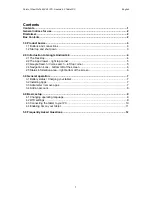
Product name: Lithium ion rechargeable battery cell
Reference number: SDS-IBT-00026
Establishment / Revision: Jan. 1, 2013
1/5
Safety data sheet for product
1. PRODUCT AND COMPANY IDENTIFICATION
・
Product name: Lithium ion rechargeable battery cell
・
Product code: None
(All models Sanyo manufactured and whose capacity is less than or equal to 5.4Ah,
excluding the cell whose shape is prismatic and two or more side of short / middle / long
side excess 12mm/85mm/110mm.)
・
Company name:
Energy Company, Sanyo Electric Co., Ltd.
・
Address:
222-1 , Kaminaizen, Sumoto City, Hyogo, Japan
・
Telephone number:
+81-799-24-4111
・
Fax number: +81-799-23-2879
・
Emergency telephone number: [Weekday] +81-799-23-3931
[Night and holiday] +81-799-24-4131
2. COMPOSITION / INFORMATION ON INGREDIENTS
・
Substance or preparation: Preparation
・
Information about the chemical nature of product: *1
Portion
Material name
Concentration
range (wt %)
Positive electrode
Lithium transition metal oxidate (Li[M]
m
[O]
n
*2)
20~60
Positive electrode’s base
Aluminum
1~10
Negative electrode
Carbon
10~30
Negative electrode’s base
Copper
1~15
Electrolyte
Organic electrolyte principally involves ester
carbonate
5~25
Outer case
Aluminum, iron, aluminum laminated plastic
1~30
*1 Not every product includes all of these materials.
*2 The letter M means transition metal and candidates of M are Co, Mn, Ni and Al. One compound
includes one or more of these metals and one product includes one or more of the compounds.
The letter m and n means the number of atoms.
3. HAZARDS IDENTIFICATION
For the battery cell, chemical materials are stored in a hermetically sealed metal or metal laminated plastic
case, designed to withstand temperatures and pressures encountered during normal use. As a result, during
normal use, there is no physical danger of ignition or explosion and chemical danger of hazardous materials'
leakage.
However, if exposed to a fire, added mechanical shocks, decomposed, added electric stress by miss-use,
the gas release vent will be operated. The battery cell case will be breached at the extreme, hazardous
materials may be released.
Moreover, if heated strongly by the surrounding fire, acrid gas may be emitted.
・
Most important hazard and effects
Human health effects:
Inhalation: The steam of the electrolyte has an anesthesia action and stimulates a respiratory tract.
Skin contact: The steam of the electrolyte stimulates a skin. The electrolyte skin contact causes a
sore and stimulation on the skin.
Eye contact: The steam of the electrolyte stimulates eyes. The electrolyte eye contact causes a sore
and stimulation on the eye. Especially, substance that causes a strong inflammation of the eyes is
contained.
Environmental effects: Since a battery cell remains in the environment, do not throw out it into the
environment.
・
Specific hazards:
If the electrolyte contacts with water, it will generate detrimental hydrogen fluoride.
Since the leaked electrolyte is inflammable liquid, do not bring close to fire.























